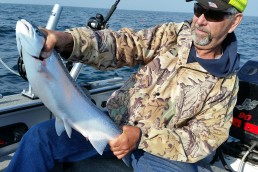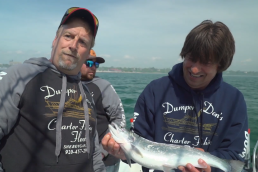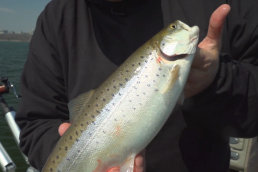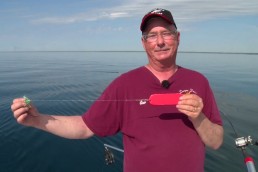Spring Coho Salmon
SHARE THIS POST
Coho salmon show up in large numbers off Lake Michigan shores starting in May and early June. Cool 50- to 52-degree water temps allow both large and small boats, as well as shore anglers to harvest these tasty fish. Limit catches are not at all unusual when the coho are feeding voraciously User-friendly coho are often stacked up tight schools. Odds are, until their larger cousins the Chinook salmon show up, you won’t get any hits that are line burning “screamers.” What you will have is fast action, big numbers and one of the best-eating salmonids in Lake Michigan.
Water temperatures permitting, coho salmon tend to stay in the upper half of the water column. Work the top half, and spread out your baits. As always, if you find large schools of bait, stay in and work that area. Set downrigger lines at or slightly above the level at which baitfish are marked. Leadcore lines can be run off to the side on planer boards or run “flat” straight behind the boat. Oftentimes, the distinct temperature breaks in water column in Lake Michigan haven’t really set up yet. Fish tend to be scattered at different depths, and even cold-water-loving fish like lake trout can be caught in bands of colder water. Scatter baits at varying depths until you find a pattern that works.
The classic combination of a fly and dodger has probably boated more coho salmon than any other lure. We always start with an orange dodger and a green/red fly with silver tinsel. I’m sure in the 30 years or so we have run this combination, hundreds of coho have fallen for it. Try orange, chrome or chartreuse dodgers and any color combination of flies, until you find what the fish like. That killer combination of an orange dodger and blue fly that killed ‘em last week might not be the perfect set-up this week. If for example, the “hot ticket” for the day is a chrome dodger and purple fly, put out as many of those as you can.
Remember to keep the length of line between the dodger and the fly no more than 1 1/2 times the length of the dodger. Lately, coho trolling flies seem to be tied in shorter lengths. We run a few peanut-type flies, as well as flies at 3 to 4 inches long. I think the larger flies give the fish a better target. Steelhead and brown trout often hit flies run flat and away from the boat. We sometimes run a fly-dodger combination with a ¾-ounce lead bead chain weight way back as trout insurance.
Are you enjoying this post?
You can be among the first to get the latest info on where to go, what to use and how to use it!
Seeing as coho average 2 to 4 pounds this time of year, keep your baits on the smaller side. Most of the alewives they are eating are 3 to 4 inches long, so “match the hatch.” Smaller spoons in green/silver, blue/silver, pearl, and bright florescent colors like orange or chartreuse can be very productive. I have an old green and chartreuse Andy Reekers spoon from the ‘80s that still catches coho ever year. Scaled-down versions of J-Plugs and diving crankbaits like Thin Fins or Hot n’ tots are also good bets. Run a full-size bait like a J-Plug or Slammer spoon down on a deeper line just in case a stray Chinook salmon or lake trout shows up.
Shore anglers can also get in on the action. Cast classic salmon spoons like Cleos, Daredevles, K.O. Wobblers or Kastmasters off a breakwall before first light. I tend to use glow-in-the-dark or florescent colors in low light, and flashy blue/silver and green/silver when the sun comes up. Make your casts in a fan-shaped pattern, and vary the depth and speed of your retrieve. Soaking a minnow or alewife on a slip bobber or on a bottom walker rig is also a good bet. A floating jig head or Styrofoam floater bead will keep the bait up off the bottom.
Unlike midsummer when you may have to venture out to 100 to 200 feet or more of water, spring coho are often close to shore. Weather and waves permitting, this is when smaller boats and even kayaks can venture out on Lake Michigan and catch fish. Now is the time to stock up on those good eaters before the fish scatter far and wide. Good luck, and good fishing.
MWO
SHARE THIS POST
Did you enjoy this post?
You can be among the first to get the latest info on where to go, what to use and how to use it!
Ron Stresing
Ron Stresing has fished since age 4 and hunted since age 12, with a lifelong passion for both. He tries to convey the lessons learned over a lifetime of hunting and fishing in Wisconsin. He also writes a column on shotguns for On Wisconsin Outdoors.



